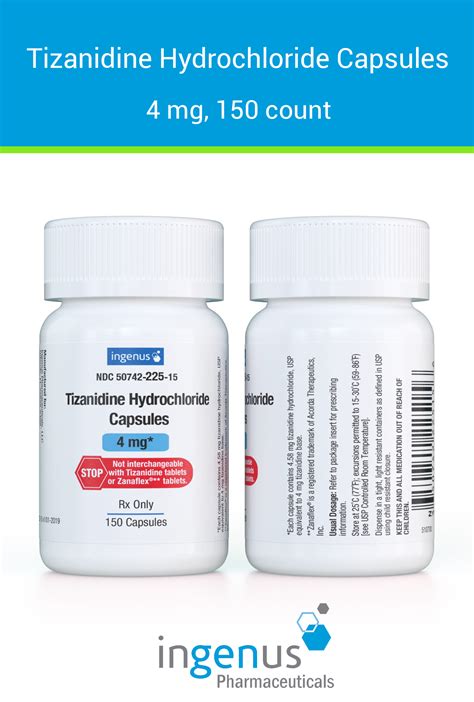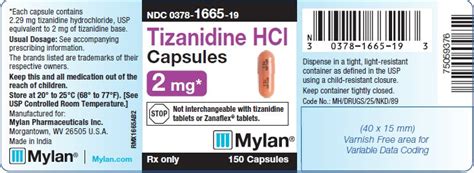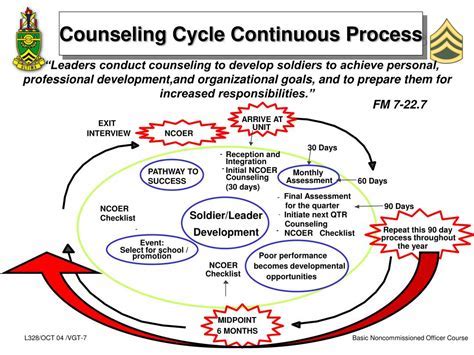Intro
The importance of understanding how certain medications work cannot be overstated, especially when it comes to managing conditions like muscle spasms. Tizanidine HCl, a medication known for its efficacy in treating muscle spasticity, has been a subject of interest for many due to its unique mechanism of action. For individuals suffering from muscle spasms, whether due to conditions like multiple sclerosis or spinal cord injuries, understanding how Tizanidine HCl works can provide valuable insights into its potential benefits and limitations. This knowledge can empower patients to make informed decisions about their treatment options and to better manage their condition.
Muscle spasms can significantly impact an individual's quality of life, affecting mobility, comfort, and overall well-being. The search for effective treatments has led to the development of various medications, including Tizanidine HCl. As a centrally acting alpha-2 adrenergic agonist, Tizanidine HCl offers a distinct approach to managing muscle spasticity. By delving into the specifics of how Tizanidine HCl works, individuals can gain a deeper understanding of its therapeutic potential and how it might address their specific needs.
The mechanism of action of Tizanidine HCl is multifaceted, involving several key pathways that ultimately lead to the reduction of muscle spasms. This complexity underscores the importance of a comprehensive approach to understanding its effects. By exploring the various ways Tizanidine HCl operates, it becomes clear that its benefits extend beyond mere symptom management, potentially offering a significant improvement in the quality of life for those affected by muscle spasticity.
Introduction to Tizanidine HCl Mechanism

Tizanidine HCl works by interacting with alpha-2 adrenergic receptors in the brain and spinal cord. This interaction leads to a decrease in the release of excitatory neurotransmitters, which are chemicals that stimulate muscle contractions. By reducing the activity of these neurotransmitters, Tizanidine HCl helps to relax muscles and reduce spasms. This mechanism is central to its effectiveness in treating muscle spasticity.
Key Pathways Involved
The pathways involved in the action of Tizanidine HCl include the inhibition of excitatory neurotransmitter release and the enhancement of inhibitory neurotransmission. This dual action contributes to its muscle relaxant properties. Furthermore, Tizanidine HCl's ability to cross the blood-brain barrier efficiently allows it to exert its effects directly on the central nervous system, making it a potent agent in the management of muscle spasms.Benefits of Tizanidine HCl

The benefits of Tizanidine HCl are multifaceted, including its rapid onset of action, which provides quick relief from muscle spasms. Additionally, its short duration of action allows for flexible dosing schedules, which can be tailored to the individual's needs. This flexibility, combined with its efficacy, makes Tizanidine HCl a valuable option for those seeking to manage muscle spasticity effectively.
Efficacy and Safety Profile
Studies have demonstrated the efficacy of Tizanidine HCl in reducing muscle tone and relieving spasms. Its safety profile, while including potential side effects such as drowsiness and dry mouth, is generally considered favorable, especially when used as directed. The balance between efficacy and safety underscores the importance of careful patient selection and monitoring.Comparative Analysis with Other Muscle Relaxants

When compared to other muscle relaxants, Tizanidine HCl offers a unique profile that sets it apart. Its central action and specific receptor targeting differentiate it from peripherally acting muscle relaxants. This distinction can be crucial for patients who have not responded well to other treatments or who are seeking an alternative with a different side effect profile.
Pharmacokinetics and Metabolism
Understanding the pharmacokinetics and metabolism of Tizanidine HCl is essential for optimizing its use. It is extensively metabolized by the liver and has a relatively short half-life, which influences dosing frequency and potential interactions with other medications. This knowledge can help healthcare providers make informed decisions about treatment regimens and minimize the risk of adverse effects.Practical Applications and Considerations

In practical terms, the use of Tizanidine HCl requires careful consideration of several factors, including the patient's medical history, current medications, and specific needs related to muscle spasticity management. Dosage adjustments and monitoring for side effects are crucial components of its effective and safe use.
Patient Education and Compliance
Educating patients about the proper use of Tizanidine HCl, its potential side effects, and the importance of adherence to the prescribed regimen is vital. By empowering patients with this knowledge, healthcare providers can enhance treatment outcomes and improve patient satisfaction.Future Directions and Research

Looking ahead, research into Tizanidine HCl and its applications continues to evolve. Investigations into its potential uses beyond muscle spasticity, as well as efforts to develop new formulations or combination therapies, highlight the ongoing interest in this medication. As our understanding of muscle physiology and the pathophysiology of spasticity deepens, so too will the possibilities for innovative treatments.
Emerging Trends and Technologies
The integration of emerging trends and technologies, such as personalized medicine and advanced drug delivery systems, may further enhance the therapeutic potential of Tizanidine HCl. By leveraging these advancements, it may be possible to tailor treatment more precisely to individual patient needs, thereby optimizing outcomes.Conclusion and Final Thoughts

In conclusion, Tizanidine HCl represents a valuable option for the management of muscle spasticity, offering a unique mechanism of action and a range of benefits that can significantly improve the quality of life for affected individuals. As research continues to uncover new aspects of its pharmacology and therapeutic potential, its role in clinical practice is likely to evolve. For those seeking to understand how Tizanidine HCl works and its implications for treatment, this exploration serves as a foundational step towards informed decision-making and optimized care.
Final Considerations
Ultimately, the effective use of Tizanidine HCl hinges on a comprehensive understanding of its workings, coupled with careful patient management and ongoing research into its applications. By embracing this multifaceted approach, healthcare providers and patients alike can work towards achieving the best possible outcomes in the management of muscle spasticity.What is Tizanidine HCl used for?
+Tizanidine HCl is primarily used for the treatment of muscle spasticity, which can result from conditions such as multiple sclerosis, spinal cord injuries, or stroke.
How does Tizanidine HCl work?
+Tizanidine HCl works by acting on the central nervous system to reduce the release of excitatory neurotransmitters, thereby reducing muscle tone and relieving spasms.
What are the common side effects of Tizanidine HCl?
+Common side effects include drowsiness, dry mouth, and dizziness. It is essential to discuss potential side effects with a healthcare provider before starting treatment.
Can Tizanidine HCl be used with other medications?
+Tizanidine HCl can interact with other medications, including certain antidepressants and blood pressure medications. Patients should inform their healthcare provider about all medications they are taking before starting Tizanidine HCl.
How should Tizanidine HCl be taken?
+Tizanidine HCl should be taken exactly as prescribed by a healthcare provider. It is usually taken every 6 to 8 hours, and the dosage may need to be adjusted based on the patient's response and tolerance.
We hope this comprehensive overview of Tizanidine HCl has provided valuable insights into its mechanism of action, benefits, and practical considerations. Whether you are a healthcare professional seeking to enhance your knowledge or a patient looking to understand your treatment options better, we invite you to share your thoughts, ask questions, or explore further resources on this topic. Your engagement and feedback are crucial in continuing the conversation about effective management of muscle spasticity and improving patient outcomes.
